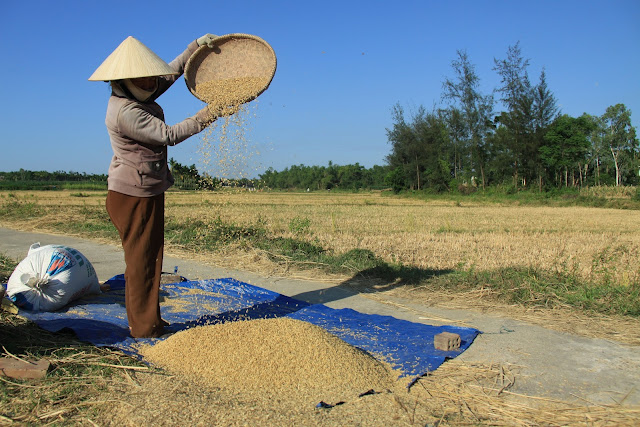Avec deux semaines de vélos dans les
jambes, il était temps de faire une pause en atteignant le centre du pays. On
ne pouvait mieux tomber qu’à Hoi An, ancien port important du pays, réputé
maintenant pour sa cuisine, ses nombreux restaurants et la douceur de vivre qui
y règne.
Le centre ville, protégé par
l’Unesco, rassemble de façon harmonieuse de nombreuses villas coloniales, des
temples, pagodes et maisons mélangeant les styles vietnamiens, chinois et
japonais. On parcoure tranquillement les rues piétonnes en admirant les façades
colorées de jaunes et les milliers de tuiles concaves et convexes couvrant les
bâtiments.
After the strenuous day in the central
highlands, the medieval-looking city of Hoi An with an infinite choice of
restaurants and cafes was welcomed break. Once Vietnam’s most cosmopolitan
port, Hoi An is now one of the main tourist destinations in Vietnam. Colonial
villas, temples, pagodas and ancient buildings with both Chinese and Japanese
influences fill the UNESCO protected pedestrian lanes in the Old Town.
Au soir, les centaines de lanternes viennent illuminer le centre ancien et la promenade le long de l’eau ou l’on s’assied pour manger un délicieux Cao Lao, une salade de nouilles au porc et aux herbes.
In the evenings the beautiful yellow
coloured facades are illuminated with colorfu lanterns, creating a nice
atmosphere and inviting you to dine at one of the many stalls along the river.
One of our favorite dishes was Cao Lao, a delicious dish of noodles, porc and
fresh herbs.
Hoi An is also famous for its tailored
clothes. The city is packed with boutiques and tailors, all offering the same
things or as the locals like to say “same same but different”. On our arrival I
was determined not to give in the temptation on getting some clothes made, but
my good intentions were quickly thrown out of the window. By the time we left
Hoi An we had a large parcel in the post, waiting for our return…
Assis en terrasse avec les meilleurs
pains au chocolat, glaces et autres pâtisseries du voyage, difficile de bouger
de son siège. L’endroit est d’ailleurs idéal pour s’essayer a la cuisine locale
et la préparation de plats comme les calamars à la citronnelle ou le poulet
caramélisé.
On parcoure quand même les
villages de campagne voisins, spécialisés entre autre dans la poterie
Our favorite way to pass time was to sit on
a terrace and eating warm “pain au chocolat” or ice cream while people watching.
It was the ideal place to learn some more about the local cuisine so we treated
our selves to another cooking class, caramelized chicken, fish in banana leave
and squid with lemon grass and chili were on the menu this time.
As it was very easy to do very little, it
even took us a few days before we headed out of the city to explore the back
roads of the surrounding villages famous for its pottery, the nearby island or
the beach.
La route remontant vers Hue longeant cote offre de nombreux panoramas sur la mer et sur la vie rurale de la région.
Le principal intérêt de Hue est
sa citadelle, construite tout au long du 19 ème siècle alors que la ville était
encore la capitale impériale du pays. En grande partie détruite pendant la
guerre, elle rassemble encore quelques pavillons bien restaures.
The road to Hue was a pleasant ride along
the coastline with stunning views over the sea and the rural countryside.
The principle attraction in Hue is the
citadel, built between 1804. The 2m
thick and 10km long walls protect the imperial enclosure which basically consists
of a citadel within a citadel. Although today only a fraction of the original
construction is left (most of it has been bombed during the war with the French
and the Americans) it is still an impressive site with some beautiful pavilions.
A la sortie d’un supermarché,
nous faisons un peu par hasard la rencontre avec une famille vietnamienne.
Apres quelques minutes de discussions, Tranh, le père de famille, nous invite a
passer la soirée avec eux pour un
barbecue. Nous acceptons avec plaisir cette proposition assez inattendue et
partageons de très bons moments chez eux le lendemain, entre la préparation du
repas, assis par terre dans la cuisine, la cuisson dans sa petite cour ou la
partie de billard tard dans la soirée…
Leaving a supermarket one day, we randomly
got chatting with a Vietnamese family. After a few minutes, Tran, the father, invited
us spontaneously to join him and his family for dinner the following day. We
happily accepted his kind offer and spent some memorable moments together
preparing the meal on the kitchen floor and cooking in his little courtyard. After
a delicious dinner he took us to a local bar to play pool and drink beers (he
seemed to be rather proud of the amount of beers he could drink in a day - a
good enough reason for us not to get back on the bike with him later on).
Unfortunate for him the poor lad quickly realized that we were not exaggerating
when we told him that unlike most Vietnamese we are really rubbish at pool!



















































































